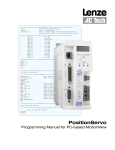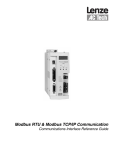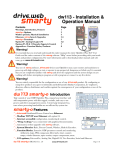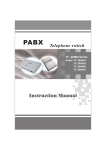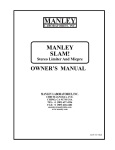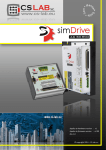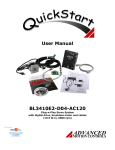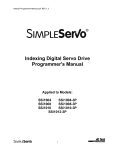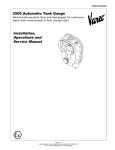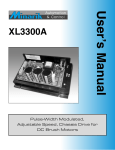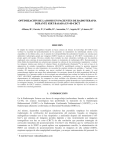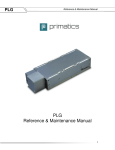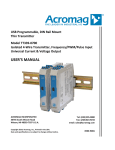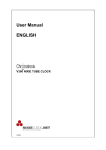Download SimpleServo® Digital Servo Amplifier USER`S MANUAL
Transcript
SimpleServo 100/200 User Manual Rev 3.4 SimpleServo® Digital Servo Amplifier USER'S MANUAL MODELS: SS108DC SS208DC SS108AC SS208AC 1 SimpleServo 100/200 User Manual Rev 3.4 Copyright ©2001 by AC Technology Corporation All rights reserved. No part of this manual may be reproduced or transmitted in any form without written permission from AC Technology Corporation. The information and technical data in this manual are subject to change without notice. AC Technology Corporation and its Divisions make no warranty of any kind with respect to this material, including, but not limited to, the implied warranties of its merchantability and fitness for a given purpose. AC Technology Corporation and its Divisions assume no responsibility for any errors that may appear in this manual and make no commitment to update or to keep current the information in this manual. MotionView, SimpleServo, and all related indicia are either registered trademarks or trademarks of AC Technology Corporation in the United States and other countries. Printed in the United States of America. 2 SimpleServo 100/200 User Manual Rev 3.4 Table Of Contents General Information ...................................................................................................................................... 5 Specifications ................................................................................................................................................ 6 Electrical Characteristics ........................................................................................................................... 6 Environment .............................................................................................................................................. 6 Dimensions and Weight............................................................................................................................. 7 Operating Modes ....................................................................................................................................... 7 Connections............................................................................................................................................... 7 SS108DC/SS208DC Dimensions ................................................................................................................. 8 SS108AC/SS208AC Dimensions.................................................................................................................. 9 Installation ................................................................................................................................................... 10 Wiring .......................................................................................................................................................... 11 Shielding and grounding.......................................................................................................................... 11 EMI Protection ......................................................................................................................................... 12 Enclosure................................................................................................................................................. 12 Line filtering ............................................................................................................................................. 12 Heat sinking............................................................................................................................................. 12 Line fusing ............................................................................................................................................... 13 SimpleServo Connections ....................................................................................................................... 13 Encoder Feedback .................................................................................................................................. 13 Wire size.................................................................................................................................................. 13 Connectors .............................................................................................................................................. 14 I/O details ................................................................................................................................................ 19 Operations................................................................................................................................................... 21 Configure the SimpleServo ..................................................................................................................... 21 Diagnostic LED........................................................................................................................................ 22 Enabling the drive.................................................................................................................................... 22 Appendix A.................................................................................................................................................. 23 A1. SimpleServo connections ................................................................................................................ 23 A2. SimpleServo Indexer Follower (SS208XX models only)................................................................... 26 Appendix B.................................................................................................................................................. 28 Troubleshooting....................................................................................................................................... 28 Warranty and Other Info.............................................................................................................................. 30 A. WARRANTY........................................................................................................................................ 30 B. PRODUCT CHANGES........................................................................................................................ 30 C. RECEIVING ........................................................................................................................................ 30 D. CUSTOMER MODIFICATION ............................................................................................................ 30 3 SimpleServo 100/200 User Manual Rev 3.4 Safety Warnings • The symbol shown at left indicates an important safety consideration. Please read this manual carefully before performing any of the procedures contained herein. Failure to follow these instructions may result in equipment damage, fire, severe injury, or fatality. • Have a qualified electrical maintenance technician install, adjust and service this equipment. Follow the National Electrical Code and all other applicable electrical and safety codes, including the provisions of the Occupational Safety and Health Act (OSHA), when installing equipment. • The symbol shown at left indicates additional information, shortcuts, or tips that do not affect the safe operation of the drive. • Reduce the chance of an electrical fire, shock, or explosion by proper grounding, over-current protection, thermal protection, and enclosure. Follow sound maintenance procedures. • It is possible for a drive to run at full speed as a result of a component failure. Please ensure that a master switch has been placed in the AC line to stop the drive in an emergency. WARNING! Hazard of electrical shock! Circuit potentials are at 115 VAC or 230 VAC above earth ground. Avoid direct contact with the printed circuit board or with circuit elements to prevent the risk of serious injury or fatality. Disconnect incoming power and wait 60 seconds before servicing drive. Capacitors retain charge after power is removed. 4 SimpleServo 100/200 User Manual Rev 3.4 General Information The SimpleServo family of servo amplifiers is an economical solution to today's complex motioncontrol needs. The SimpleServo combines a Digital Signal Processor (DSP), controller, heat sink and power supply in one standalone, DIN-rail mountable or panel-mounted unit. The SimpleServo can be operated as a stand-alone unit or as a digital amplifier. The SimpleServo controls brushless motors with a high switching (carrier) frequency for virtually silent operation. Most servomotors used today require high precision control and a smooth, sinusoidally commutated signal. An on-board DSP provides commutation by generating the three-phase sine wave, using feedback information from an optical encoder. The servo will accept feedback from an encoder that includes Hall sensor feedback information. It accepts commands from a variety of sources, including analog voltage, PWM and internal reference signals. The control will operate in current mode (torque), velocity mode, or position mode (step and direction). Upon initial start up, the motor is commutated using the hall sensors-for the first two or three mechanical degrees of motor rotation-to map the encoder; the Hall-effect information is unnecessary thereafter. The SimpleServo's built-in RS-232 serial communications port and servo control program, MotionView™, make programming extremely simple. In fact, you could be up and running in less than thirty minutes! Each SimpleServo unit is an amplifier, power supply, controller and heat sink integrated into a single standalone package. The SimpleServo will only accept an encoder with Hall or an encoder with hall-commutation tracks encoded on the feedback device. 5 SimpleServo 100/200 User Manual Rev 3.4 Specifications ELECTRICAL CHARACTERISTICS Drive SS108DC SS208DC SS108AC SS208AC Maximum Continuous Current (AC) 5 5 Continuous Phase Current (AC RMS) 8A 8A 8A 8A Peak Current (AC RMS) 12A 12A 12A 12A Input Voltage 80 - 170 80 - 170 60 - 120 60 - 120 Applies to all models: AC Output Voltage Range (Sinusoidal, Three-Phase) 0 - 120 VAC RMS Acceleration Time Range (Zero to Max Speed) 0.1 - 5000000 Rpm/sec Deceleration Time Range (Max Speed to Zero) 0.1 - 5000000 Rpm/sec Speed Regulation (typical) ± 0.5 RPM Input Impedance (+REF to COM and +REF to -REF) 47 kohms Power Device Switching Frequency (sinusoidal commutation) 16 kHz Encoder power supply (max) +5 VDC @ 300 mA Maximum encoder feedback frequency 2.5 MHz ENVIRONMENT Vibration 0.1 G (all frequencies) 0.5G max (20 - 50 Hz) 0.1G max (>50 Hz) Shock 1.0 g @10 m/sec Ambient Operating Temperature Range 0 to 40ºC Ambient Storage Temperature Range -10 to 70ºC Humidity 5 - 90% non-condensing Altitude** 1500 m/5000 ft **derate by 1% per 300m (1000 ft) above 1500m (5000 ft) 6 SimpleServo 100/200 User Manual Rev 3.4 DIMENSIONS AND WEIGHT Model S108DC SS208DC SS108AC SS208AC Height (inches) 7.35 7.35 7.35 7.35 Width (inches) 1.25 1.25 2.5 2.5 Depth (inches) 4.40 4.40 4.40 4.40 OPERATING MODES Torque Reference 0 ± 10 VDC or 0 to 10 VDC, scalable Accuracy ± 0.01 amp Current-Loop Bandwidth up to 2.5 kHz Velocity Reference 0 ± 10 VDC or 0 to 10 VDC Accuracy ± 0.5 RPM Velocity-Loop Bandwidth up to 300 Hz Speed Range up to 8000:1 Position (SS208AC SS208DC only) Reference Step and direction signals or Master Encoder full quadrature signal (software selectable). Minimum Pulse Width 250 nanoseconds Reference Max frequency 2 MHz Position-Loop Bandwidth Up to200 Hz Accuracy ±1 encoder count CONNECTIONS Serial Standard 9-pin D-shell Encoder Feedback Standard 15-pin D-shell I/O 15-pin removable terminal block or 25-pin D-shell Power in SS108AC, SS208AC 3-pin AC socket SS108DC, SS108DC 15-pin removable terminal block or 25-pin D-shell Windows® Software: MotionViewTM (Windows 95, 98, NT) 7 SimpleServo 100/200 User Manual Rev 3.4 SS108DC/SS208DC Dimensions DIM "A" DIM "B" DIM "C" DIMENSIONS A 4.25 [108] B 7.25 [185] ALL DIMENSIONS IN INCHES [MILLIMTERS] 8 SimpleServo 100/200 User Manual Rev 3.4 SS108AC/SS208AC Dimensions DIM "A" DIM "B" DIM "C" DIMENSIONS A 4.25 [108] B 7.25 [185] ALL DIMENSIONS IN INCHES [MILLIMTERS] 9 SimpleServo 100/200 User Manual Rev 3.4 Installation WARNING! Hazard of electrical shock! Circuit potentials are at 115 VAC or 230 VAC above earth ground. Avoid direct contact with the printed circuit board or with circuit elements to prevent the risk of serious injury or fatality. Disconnect incoming power and wait 60 seconds before servicing drive. Capacitors retain charge after power is removed. • The SimpleServo must be mounted vertically for safe operation at the maximum current rating. • Printed circuit board components are sensitive to electrostatic fields. Avoid contact with the printed circuit board directly. Hold the SimpleServo by the case only. • Protect the control from dirt, filings, airborne particles, moisture, and accidental contact. Provide sufficient room for access to the terminal block. • Mount the control away from other heat sources. Operate within the specified ambient operating temperature range. Additional cooling with an external fan may be recommended in certain applications. • Avoid excessive vibration to prevent intermittent connections. • DO NOT connect incoming power to the output motor terminals (U, V, W)! Severe damage to the SimpleServo will result. • Do not disconnect any of the motor leads from the SimpleServo unless power is removed or the control is disabled. Opening any one motor lead may cause failure. 10 SimpleServo 100/200 User Manual Rev 3.4 Wiring WARNING! Hazard of electrical shock! Circuit potentials are at 115 VAC or 230 VAC above earth ground. Avoid direct contact with the printed circuit board or with circuit elements to prevent the risk of serious injury or fatality. Disconnect incoming power and wait 60 seconds before servicing drive. Capacitors retain charge after power is removed. • Under no circumstances should power and logic wiring be bundled together. Induced voltage can cause unpredictable behavior in any electronic device, including motor controls. • Use 18-28 AWG wire for reference and analog signal wiring. Use 12-16 AWG wire for AC line (L1 and L2) and motor (Phase U, V and W) wiring. SHIELDING AND GROUNDING AC Technology Corp recommends the use of single-point grounding (SPG) for panel-mounted controls. Serial grounding (a "daisy chain") is not recommended. The SPG for all enclosures must be tied to earth ground at the same point. The system ground and equipment grounds for all panel-mounted enclosures must be individually connected to the SPG for that panel using 14 AWG (5.5 mm) or larger wire. Refer to Figure 6 for wiring guidelines. In order to minimize EMI, the chassis must be grounded to the mounting panel (Figure 6). Use 14 AWG (1.6 mm) or larger wire to join the enclosure to earth ground. A lock washer must be installed between the enclosure and ground terminal. To ensure maximum contact between the terminal and enclosure, remove paint in a minimum radius of 0.25 in (6 mm) around the screw hole of the enclosure. AC Technology Corp recommends the use of the special servo cables provided by AC Technology Corp. If you specify cables other than those provided by AC Technology Corp, please make sure all cables are shielded and properly grounded. It may be necessary to earth ground the shielded cable (Figure 6). Ground the shield at the SimpleServo end and at the motor end. If the SimpleServo continues to pick up noise after grounding the shield, it may be necessary to add an AC line filtering devices and/or an output filter (between drive and servomotor). 11 SimpleServo 100/200 User Manual Rev 3.4 EMI PROTECTION Electromagnetic interference (EMI) is an important concern for users of digital servo control systems. EMI will cause control systems to behave in unexpected and sometimes dangerous ways. Therefore, reducing EMI is of primary concern not only for servo control manufacturers such as AC Technology Corp, but the user as well. Proper shielding, grounding and installation practices are critical to EMI reduction. ENCLOSURE The panel in which the servo is mounted must be made of metal, and must be grounded using the SPG method outlined above. Proper wire routing inside the panel is critical; power and logic leads must be routed in different avenues inside the panel. If you use drives that output over 8 amps, you must ensure that the panel contains sufficient clearance above and below for the cooling fan to circulate air. Refer to Figure 3 for minimum suggested cooling air clearance. LINE FILTERING In addition to EMI/RFI internal filter in the SimpleServo SS108AC/SS208AC, external filtering may be required. High frequency energy can be coupled between the circuits via radiation or conduction. The AC power wiring is one of the most important paths for both types of coupling mechanisms. There are many AC line filter manufacturers whose filters can be successively integrated. AC Technology Corp recommends Schaffner filters based on our test results. HEAT SINKING SimpleServos contain sufficient heat sinking in their basic configuration. There is no need for additional heat sinking. However, drives that output more than 8 amps incorporate a heat sink cooling fan; you must ensure that there is sufficient clearance for the cooling fan to circulate air (Figure 3). As a minimum, you must allow an air gap of 1 inch above and below the drive. 12 SimpleServo 100/200 User Manual Rev 3.4 LINE FUSING External line fuses must be installed on all SimpleServos. Connect the external line fuse in series with the AC line voltage input. Table 3 lists the recommended line fuse sizes. Use fast acting fuses rated for 250 VAC or higher, and approximately 200% of the maximum phase current. Table 2. Recommended Line Fuse Sizes. MODEL AC LINE FUSE SIZE NUMBER (AC Amps) SS108/200 25 SIMPLESERVO CONNECTIONS Prefabricated cable assemblies may be purchased from AC Technology Corp to facilitate wiring the control, motor and host computer. Contact your AC Technology Corp sales representative for assistance. ENCODER FEEDBACK An encoder needs to have power supplied to it. SimpleServo has a +5 VDC supply voltage that is used to power the encoder. If front-end controller power supply needs to be used to power the encoder one has to be disconnected from SimpleServo power supply by removing connections to PWR +5V pins. WARNING! Use only +5 VDC encoders. Do not connect any other type of encoder to the SimpleServo reference voltage terminals. When using a front-end controller, it is critical that the +5 VDC supply on the front-end controller NOT be connected to the +5 VDC supply on the SimpleServo, as this will result in damage to the SimpleServo. Note: AC Technology Corp recommends an encoder resolution of 2000 PPR or higher for optimum performance. WIRE SIZE If current draw is less than 8 amps: 16 AWG (1.0 mm) or 14 AWG (1.6 mm) If current draw is greater than 8 amps, but less than 12 amps: 14 AWG (1.6 mm) or 12 AWG (2.6 mm) If current draw is greater than 12 amps: 12 AWG (2.6 mm). 13 SimpleServo 100/200 User Manual Rev 3.4 CONNECTORS AC power in (AC models only) This power entry connector located on the bottom and made to accommodate standard 3-prong computer AC cable plug. WARNING! DO NOT connect incoming power to the output motor terminals (U, V, W)! Severe damage to the SimpleServo will result. Note: All conductors must be enclosed in one shield and jacket around them. The shield on the amplifier end must be terminated at the case (chassis ground); the other end should be properly terminated at the motor shield. To satisfy CE requirements, AC Technology Corp recommends that you purchase SimpleServo cables for both the motor and AC line. Contact your AC Technology Corp representative for assistance. DC power in (DC models only) DC power is connected via terminals 1 and 2 on TB1 connector. See description of TB1 functions below. WARNING! DO NOT connect incoming power to the output motor terminals (U, V, W)! Severe damage to the SimpleServo will result. TB1 - Power (DC units only), Motor and Fuse Connections Table 3. TB1 Pin Assignments Terminal Block Pin # Name FUNCTION 1 W (T) +DC in (DC models only) 2 V (S) -DC in (DC models only) 3 W (T) Motor Power Out 4 V (S) Motor Power Out 5 U (R) Motor Power Out 14 SimpleServo 100/200 User Manual Rev 3.4 TB2 - Analog/Digital I/O Terminal Block TB502 is a 15-pin quick-connect header used for analog and digital I/O functions. Refer to Table 4 for connector pin assignments. Table 4. TB2 Pin Assignments Terminal Block Pin # Name Function 1 +Vcc +Vcc (5mA) 2 AGND 3 -Vcc +Vcc (5mA) 4 REF+ Positive reference input (differential) 5 REF- Negative reference input (differential) 6 Shield Shield connection 7 Analog Output 1 Programmable analog output 8 Analog Output 2 Programmable analog output 9 Enable 10 5 VDC out 11 GND 12 MA-/Step+ Step- (or master encoder channel A-) input2 13 MA+/Step- Step+ (or master encoder channel A+) input2 14 MB+/Dir+ DIR+ (or master encoder channel B+) input2 15 MB-/Dir- DIR- (or master encoder channel B-) input2 16 Ready/Fault output Analog ground (Attach shield from signal source here) Enable Input1 5VDC @ 10mA power out Logic common Ready/Fault output TTL 5V 15 SimpleServo 100/200 User Manual Rev 3.4 DS1 - Motor Feedback Input from Motor DS1 is a 15-pin DB connector that contains connections for Hall effect sensors and encoder feedback. Refer to Table 5 for connector pin assignments. All conductors must be enclosed in one shield and jacket around them. AC Technology Corp recommends that each and every pair (for example, EA+ and EA-) be twisted. In order to satisfy CE requirements, AC Technology Corp recommends using OEM cable. Contact your AC Technology Corp representative for assistance. Table 5. DS1 Pin Assignments "D"-Sub Pin # Name Function 1 EA+ Encoder Channel A 2 EA- Encoder Channel A Not3 3 EB+ Encoder Channel B 4 EB- Encoder Channel B Not 5 EZ+ Encoder Channel Z 6 EZ- Encoder Channel Z Not 7 GND Drive Common/Encoder Ground 8 SHLD Shield 9 PWR Encoder supply (+5VDC)4 10 HA- Hall Sensor A- 11 HA+ Hall Sensor A+ 12 HB+ Hall Sensor B+ 13 HC+ Hall Sensor C+ 14 HB- Hall Sensor B- 15 HC- Hall Sensor C- 16 SimpleServo 100/200 User Manual Rev 3.4 DS2 (Serial Communications Port input to Servo) DS2 is a 9-pin DB connector that is used to communicate with a host computer. All levels must be RS232C compliant. Table 6. TB505 Pin Assignments "D"-Sub Pin # Name Function 1 Reserved 2 TX RS232 TX 3 RX RS232 RX 4 Reserved 5 GND 6 Reserved 7 Reserved 8 Reserved 9 Reserved Common WARNING! Do not make any connection to Reserved pins! Note: If you purchase serial cables from a third party, you must use pass-through cable, not Null-Modem (not crossover). 17 SimpleServo 100/200 User Manual Rev 3.4 Connectors and Wiring Notes Note 1 The enable (Enable) pin, TB2 pin 9, must be wired to one of the output terminals on the front-end controller, i.e., if the controller is present, it must supervise the enable function on the SimpleServo. The SimpleServo will accept open-collector outputs for use as a switch, TTL or CMOS outputs (5V) programmed for active low operation. Note 2 An external pulse train signal (for "step") supplied by an external device, such as a PLC or stepper indexer, can control the speed and position of the servomotor. The speed of the motor is controlled by the frequency of the step signal, while the number of pulses that are supplied to the SimpleServo determines the position of the servomotor. "DIR" input controls direction of the motion. Note 3 The complement of A is sometimes written as not A. The B, C and Z encoder channels are annotated in a similar fashion. Note 4 The encoder needs to have power supplied to it. The SimpleServo has a +5 VDC supply voltage that may be used to power the encoder. WARNING! Use only +5 VDC encoders. Do not connect any other type of encoder to the SimpleServo reference voltage terminals. When using a front-end controller, it is critical that the +5 VDC supply on the front-end controller NOT be connected to the +5 VDC supply on the SimpleServo, as this will result in damage to the SimpleServo. 18 SimpleServo 100/200 User Manual Rev 3.4 I/O DETAILS 1. Step and Direction/ Master Encoder Inputs: TB2-12,13,14,15 You can connect a master encoder with quadrature outputs or a step and direction to control position in step/direction operating mode. You can connect a single ended or differential TTL or CMOS compatible 5V sourcing signals to the inputs. You can also connect sink open collector outputs to these inputs. See application note in "Section A" of this manual for the connection guidelines. The function of these inputs "Master Encoder" or "Step and Direction" is software selectable. Use MotionView set up program to choose desirable function. WARNING! Inputs compatible only with 5V logic or open collector outputs. Higher voltages will damage drive's circuit. +5V U1 16 R1 5.11K R2 1K STEP+ (TB2-12) R3 C1 180pF 20K R4 1K 4 12 STEP- (TB2-13) R5 -INA +INA -INB +INB -INC +INC -IND +IND VC C OUTA OUTB OUTC OUTD 3 13 5 11 To drive's GN ENABLE ENABLE D DS26LS32AC 8 C4 180pF 20K 1 2 15 14 6 7 9 10 R6 5.11K R7 1K R9 1K DIRECTION+ (TB2-14) R8 C5 180pF 20K DIRECTION- (TB2-15) R10 20K C6 180pF Master encoder/step and direction input circuit. (SS208 drives only) 19 SimpleServo 100/200 User Manual Rev 3.4 2. Fault Digital Output On hardware revisions 1.06 and earlier: TTL compatible OC output (5V logic). High when drive is at fault, low otherwise. On hardware revision 1.07 TTL compatible output (5V logic). High when drive at fault or disabled, low otherwise. 3. Enabled digital input This is a single-ended input, compatible with 5V TTL, open-collector sink output, and switch or relay contacts. The input is referenced to drive logic common. These inputs are active low, i.e., connecting it to drive logic common or supplying logic "0" referenced to drive logic common activates this input. For connection guidelines see application note in Appendix A. See figure below for electrical diagram. 4. Analog reference input IN+, IN- (TB2-4,TB2-5) Analog differential input. This input will accept +/-10V single-ended voltage on IN+ or IN- input or +/-5V differential voltage between IN+ and IN-. Both connections must be referenced to Analog Common (TB2-2) of the drive. This input is used to control speed or torque of the motor in velocity or torque mode. The total reference voltage as seen by the drive is the voltage difference between IN+ and IN-. If used in single-ended mode one of the inputs must be connected to voltage source while the other one must be connected to Analog Common. If used in differential mode, the voltage source is connected across IN+ and IN- inputs and driving circuit common (if any) needs to be connected to drive Analog Common terminal. Reference as seen by drive: Example #1: Vin+ = 2V Vin- =0 (connected to analog ground) Vref = (2V) - (0V) = 2V (as seen by drive) Example #2: Vin+ = 2V Vin- = -1V Vref= (2V) - (-1V) = 3V (as seen by drive) Example #3: Vin+ = 2V Vin- = 1V Vref = (2V) - (1V) = 1V (as seen by drive) 20 Vref = (VIN+) - (VIN-) SimpleServo 100/200 User Manual Rev 3.4 Operations CONFIGURE THE SIMPLESERVO Regardless of the mode in which you wish to operate, you must first configure the SimpleServo for your particular motor, mode of operation and additional features if used. 1. Ensure that the control is properly installed and mounted. Refer to "INSTALLATION" section early in this manual for installation instructions. 2. Perform wiring to the motor and external equipment suitable for desired operating mode and your system requirements. Refer to system configurations diagram in Section A for various system configuration examples. 3. Connect drive serial port DS2 to your PC serial port. 4. Turn power to the drive ON. 5. Make sure that the drive is disabled. 6. Launch MotionView software on your computer. 7. From the MotionView menu, select <Project> <Connection setup> and select "RS-232" radio button on opened connection dialog. Click <Properties> and select the serial port number to which the drive is connected. Leave the rest of the settings unchanged. Click <OK> to close dialogs. 8. From menu, click <Node> then <Connect drive>. 9. Set parameters for the drive according to the section "Drive configuration procedure" in MotionView Help file. (Select <Help> <Help Topics>; expand <Quick Start> book; and select "Drive configuration procedure"). 10. After you configure the drive, proceed to tuning procedure if operating in Velocity or Step & Direction mode. Torque Mode doesn't require additional tuning or calibration. Refer to MotionView Help file book "Tuning" for instructions on how to tune for Velocity or Step & Direction mode. 21 SimpleServo 100/200 User Manual Rev 3.4 DIAGNOSTIC LED There is a bi-color diagnostic LED mounted between TB1 and TB2 connectors. LED is designed to help you monitor system status and troubleshoot any faults. LED functions: GREEN Blinking - Power ON, no fault, drive disabled GREEN Solid - Power ON, no faults, drive enabled RED Solid - General Fault RED Blinking - Under voltage ENABLING THE DRIVE Regardless of selected operating mode, the SimpleServo must be enabled before it can operate. Refer to drawing A1.3 in Appendix A for various enabling options. 22 SimpleServo 100/200 User Manual Rev 3.4 Appendix A SIMPLESERVO SYSTEM CONNECTION EXAMPLES A1. SIMPLESERVO CONNECTIONS SS108 DS2 RX RS-232 INTERFACE RS-232 1 6 2 7 3 8 4 9 5 TX PC COMPUTER CONNECTOR DB9 DS1 1 9 2 10 3 11 4 12 5 13 6 14 7 15 8 A+ +5VDC (Encoder Power) AHall AB+ Hall A+ BHall B+ Z+ Hall C+ ZHall BEncoder COM Hall C- CONNECTOR DB15 Motor Feedback TB2 ANALOG/DIGITAL I/O 1 2 3 4 5 6 7 8 9 10 11 12 13 14 15 16 TB1 5 4 3 2 1 U V W Motor Power A1.1 Motor and Host computer connection 23 BLDC MOTOR SimpleServo 100/200 User Manual Rev 3.4 WARNING! Hazard of electrical shock! Circuit potentials are at 115 VAC or 230 VAC above earth ground. Avoid direct contact with the printed circuit board or with circuit elements to prevent the risk of serious injury or fatality. Disconnect incoming power and wait 60 seconds before servicing drive. Capacitors retain charge after power is removed.o DO NOT connect incoming power to the output motor terminals (U, V, W)! Severe damage to the SimpleServo will result. SS108/208DC SS108/208AC TB1 5 4 3 2 1 TB1 DCDC+ 3 2 1 80-170VDC 100-120VAC A1.2 Incoming power connection 24 SimpleServo 100/200 User Manual Rev 3.4 Enable options SS108/208DC 9 TB2 1 2 3 4 5 6 7 8 9 10 11 12 13 14 15 16 PLC output 11 ENABLE 9 Relay output 11 5V TTL/CMOS LOGIC 9 11 Controller logic common A1.3 Enable options SS108/208 SS108/208 TB2 1 2 3 4 5 6 7 8 9 10 11 12 13 14 15 16 TB2 1 2 3 4 5 6 7 8 9 10 11 12 13 14 15 16 R? 5-25K BI-DIRECTIONAL REFERENCE CONNECTION R? 5-25K SINGLE DIRECTION REFERENCE CONNECTION A1.4 Analog reference for torque or velocity 25 SimpleServo 100/200 User Manual Rev 3.4 A2. SIMPLESERVO INDEXER FOLLOWER (SS208XX MODELS ONLY) SS208 TB2 1 2 3 4 5 6 7 8 9 10 11 12 13 14 15 16 S+ STEP S- D+ D- INDEXER WITH DIFFERENTIAL OUTPUTS DIRECTION A2.1 Indexer connections (differential outputs) 26 SimpleServo 100/200 User Manual Rev 3.4 SS208 TB2 1 2 3 4 5 6 7 8 9 10 11 12 13 14 15 16 STEP OPTO OR OPEN COLLECTOR OUTPUTS DIRECTION A2.2 Indexer connections (single ended Open Collector outputs) 27 SimpleServo 100/200 User Manual Rev 3.4 Appendix B TROUBLESHOOTING WARNING! Hazard of electrical shock! Circuit potentials are at 115 VAC or 230 VAC above earth ground. Avoid direct contact with the printed circuit board or with circuit elements to prevent the risk of serious injury or fatality. Disconnect incoming power and wait 60 seconds before servicing drive. Capacitors retain charge after power is removed. Before troubleshooting • Perform the following steps before starting any procedure in this section: • Disconnect AC or DC voltage input from the SimpleServo. Wait 3 minutes for power to discharge. • Check the SimpleServo closely for damaged components. • Check that no foreign material has become lodged on, or fallen into, the SimpleServo. • Verify that every connection is correct and in good condition. • Verify that there are no short circuits or grounded connections. • Check that the drive's rated phase current and RMS voltage are consistent with the motor ratings. For additional assistance, contact your local SimpleServo® authorized distributor. PROBLEM External line fuse blows POSSIBLE CAUSE • Line fuses are the wrong size. • Motor leads or incoming power leads are shorted to ground. • Nuisance tripping caused by EMI noise spikes caused by poor grounding and/or shielding. POSSIBLE CAUSE • Check that line fuses are properly sized for the motor being used. • Check motor cable and incoming power for shorts. • Check that you followed recommendations for proper shielding and grounding listed in section "shielding and grounding" earlier in this manual. 28 SimpleServo 100/200 User Manual Rev 3.4 PROBLEM Diagnostic LED is steady GREEN (enabled status) but motor does not run. SUGGESTED SOLUTION • If in torque or velocity mode: • Reference voltage input signal is not applied. • Reference signal is not connected to the SimpleServo input properly; connections are open. • In MotionView program check <Parameters> <Reference> set to <External> • For Velocity mode only: In Motion View check <Parameters> <Compensation> <Velocity loop filter> P-gain must be set to value more then 100 in order to run. Without load, motor will run with P-gain set as low as 20, but may not run under load. If P-gain is set to 0 motor will not run at all. • In step and direction mode: • Step and Direction inputs are not wired correctly. • In MotionView program check <Parameters> <Step input type> is set for <S/D> if you use a stepand-direction indexer output, and <Master Encoder> if you use quadrature type output from a master motor encoder or indexer. • Position loop P-gain set to 0. Set P-gain to 200 and D-gain to 200 initially to get motion. Tune them afterwards for best performance. PROBLEM In velocity mode, the motor runs away. POSSIBLE CAUSE • Hall sensors or encoder mis-wired. • SimpleServo not programmed for the connected motor. SUGGESTED SOLUTION • Check Hall sensor and encoder connections. • Check that the proper motor is selected. For more troubleshooting tips check our website: http://www.SimpleServo.com 29 SimpleServo 100/200 User Manual Rev 3.4 Warranty and Other Info A. WARRANTY AC Technology Corporation warrants the SimpleServo control to be free of defects in material and workmanship for a period of twelve months from the date of sale to the user, or eighteen months from the date of shipment, which ever occurs first. If the amplifier, under normal use, becomes defective within the stated warranty time period, contact AC Technology's Service Department for instructions on obtaining a warranty replacement unit. AC Technology Corporation reserves the right to make the final determination as to the validity of a warranty claim, and sole obligation is to repair or replace only components that have been rendered defective due to faulty material or workmanship. No warranty claim will be accepted for components which have been damaged due to mishandling, improper installation, unauthorized repair and/or alteration of the product, operation in excess of design specifications or other misuse, or improper maintenance. AC Technology Corporation makes no warranty that its products are compatible with any third party equipment, or to any specific application, to which they may be applied and shall not be held liable for any other consequential damage or injury arising from the use of its products. This warranty is in lieu of all other warranties, expressed or implied. No other person, firm or corporation is authorized to assume, for AC Technology Corporation, any other liability in connection with the demonstration or sale of its products. B. PRODUCT CHANGES AC Technology Corporation reserves the right to discontinue or make modifications to the design of its products without prior notice, and holds no obligation to make modifications to products sold previously. AC Technology Corporation also holds no liability for losses of any kind which may result from this action. Instruction manuals with the most up-to-date information are available for download from the SimpleServo website (www.simpleservo.com). C. RECEIVING Inspect all cartons for damage which may have occurred during shipping. Carefully unpack equipment and inspect thoroughly for damage or shortage. Report any damage to carrier and/or shortages to supplier. All major components and connections should be examined for damage and tightness, with special attention given to PC boards, plugs, knobs and switches. D. CUSTOMER MODIFICATION AC Technology Corporation, its sales representatives and distributors, welcome the opportunity to assist our customers in applying our products. Many customizing options are available to aid in this function. AC Technology Corporation cannot assume responsibility for any modifications not authorized by its engineering department. 30 SimpleServo 100/200 User Manual Rev 3.4 AC TECHNOLOGY CORPORATION member of the Lenze Group 630 Douglas Street Uxbridge, MA 01569 Telephone: (508) 278-9100 Facsimile: (508) 278-7873 Visit us on the web: www.SimpleServo.com $12.00 (USA) $15.00 (Outside USA) 31































